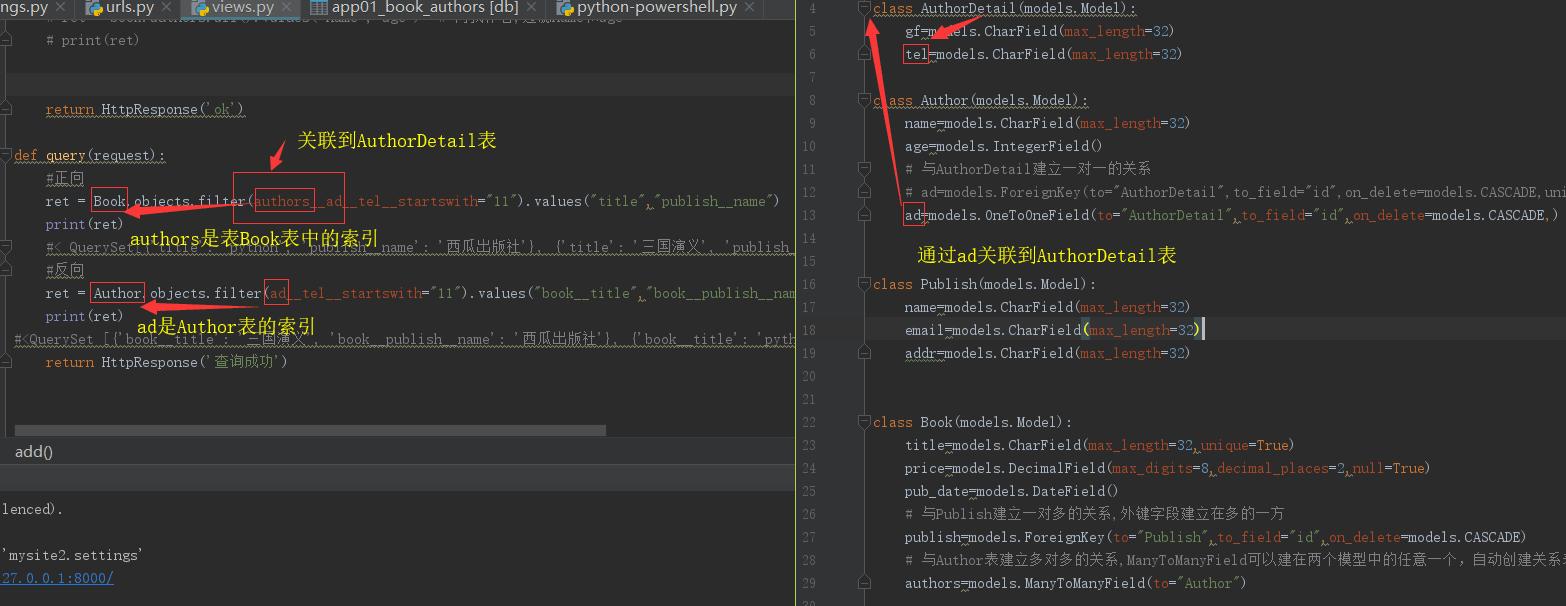当前位置:首页 » python web » 正文
本文实例讲述了django框架基于queryset和双下划线的跨表查询操作。分享给大家供大家参考,具体如下:
前面篇随笔写的是基于对象的跨表查询:对象.objects.filter(。。。) 对象.关联对象_set.all(...) -->反向
基于对象的跨表查询例如:
book_obj= Book.objects.filter(id=4).first() #注意多了个first print(book_obj) #go 这里得到的是一个models对象 print(book_obj.publish.name) #桔子出版社这篇随笔主要写的是基于双下划线的跨表查询,其本质是使用join连接其他表进行查询
一对多
def query(request): #正向查询 ret1=Book.objects.filter(title='西游记').values("publish__name") print(ret1) #<QuerySet [{'publish__name': '榴莲出版社'}]> print(ret1.first(),type(ret1.first())) #{'publish__name': '榴莲出版社'} <class 'dict'> 注意key 为 publish__name print(ret1.first()['publish__name']) # 榴莲出版社 #反向查询 ret2=Publish.objects.filter(book__title="西游记").values('name') #这里的book是表名称,book表里面有字段 title print('---------------------------------') print(ret2) #<QuerySet [{'name': '榴莲出版社'}]> print(ret2.first()['name'])#榴莲出版社 return HttpResponse('ok')多对多
#查询python书的作者的名字和年龄 def query(request): #正向查询 ret = Book.objects.filter(title="python").values("authors__name","authors__age") print(ret) #注意结果的key #结果 <QuerySet [{'authors__name': 'wang', 'authors__age': 27}, {'authors__name': 'xiao', 'authors__age': 25}, {'authors__name': 'zhang', 'authors__age': 26}]> #反向查询 ret = Author.objects.filter(book__title="python").values("name","age") print(ret) #区分正向查询的key #结果 <QuerySet [{'name': 'wang', 'age': 27}, {'name': 'xiao', 'age': 25}, {'name': 'zhang', 'age': 26}]> return HttpResponse('ok')一对一
例子:查询名字为 xiao 的gf是什么
def query(request): #正向查询 ret=Author.objects.filter(name='xiao').values('ad__gf') #Author设置了外键到 AuthorDetail print(ret) #<QuerySet [{'ad__gf': '刘诗诗'}]> #反向查询 ret=AuthorDetail.objects.filter(author__name='xiao').values('gf') print(ret) #<QuerySet [{'gf': '刘诗诗'}]> return HttpResponse('ok')下面进行跨多表查询,涉及三个表或者以上
#查询西瓜出版社出版过的书籍和书籍作者的名字 def query(request): #正向 ret=Book.objects.filter(publish__name="西瓜出版社").values_list("title",'authors__name') print(ret) #<QuerySet [('三国演义', 'zhang'), ('python', 'xiao'), ('python', 'zhang'), ('python', 'wang')]> #反向 ret = Publish.objects.filter(name="西瓜出版社").values_list("book__title","book__authors__age","book__authors__name") print(ret) #<QuerySet [('三国演义', 26, 'zhang'), ('python', 25, 'xiao'), ('python', 26, 'zhang'), ('python', 27, 'wang')]> return HttpResponse('ok')
手机号以11开头的作者出版过的所有书籍名称以及出版社名称
def query(request): #正向 ret = Book.objects.filter(authors__ad__tel__startswith="11").values("title","publish__name") print(ret) #< QuerySet[{'title': 'python', 'publish__name': '西瓜出版社'}, {'title': '三国演义', 'publish__name': '西瓜出版社'}] > #反向 ret = Author.objects.filter(ad__tel__startswith="11").values("book__title","book__publish__name") print(ret) #<QuerySet [{'book__title': '三国演义', 'book__publish__name': '西瓜出版社'}, {'book__title': 'python', 'book__publish__name': '西瓜出版社'}]> return HttpResponse('查询成功')
希望本文所述对大家基于Django框架的Python程序设计有所帮助。
-
<< 上一篇 下一篇 >>
标签:django
django框架基于queryset和双下划线的跨表查询操作详解
看: 958次 时间:2021-01-15 分类 : python web
- 相关文章
- 2021-07-20django学习之ajax post传参的2种格式实例
- 2021-07-20Python djanjo之csrf防跨站攻击实验过程
- 2021-07-20django admin实现动态多选框表单的示例代码
- 2021-07-20Flask登录注册项目的简单实现
- 2021-07-20Flask实现异步执行任务
- 2021-07-20如何使用flask将模型部署为服务
- 2021-07-20Django实现自定义路由转换器
- 2021-07-20python flask框架快速入门
- 2021-07-20Django 聚合函数的具体使用
- 2021-07-20django时区问题的解决
-
搜索
-
-
推荐资源
-
Powered By python教程网 鲁ICP备18013710号
python博客 - 小白学python最友好的网站!